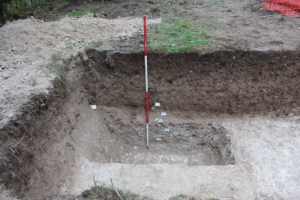Discovering the past through development
December 16, 2019
Development-led archaeology has played a crucial role in expanding our understanding of the past, fostering new discoveries and research, says Anooshka Rawden, Cultural Heritage Lead for the South Downs National Park Authority.
Crucially, it’s revealed a past that is far more populated, innovative and international than previously thought, and nurtured a strong sense of connectivity to place through community engagement.
Planning policy took a trailblazing response to the challenges that had arisen in previous decades against a backdrop of post-war urban renewal. There had been considerable public appetite for the protection of archaeological discoveries since the 1950s, and the high profile redesign of an office block at Bankside to preserve the remains of Shakespeare’s Rose Theatre in 1989 demonstrated the role of sensitive design in preserving the past. It also demonstrated how archaeologists and developers could work together to balance preservation and change, and culminated in the launch of Planning Policy Guidance 16 (PPG16) in 1990. In 2012, the National Planning Policy Framework took PPG16 and articulated its principles into the fundamentals of sustainable, sensitive development.
So what has development-led archaeology brought us? In 2017-18, 470,000 planning applications were submitted in England. Of these, only 21,700 had archaeological implication, representing 4.6 per cent. Of those applications that resulted in archaeological fieldwork (less than 2 per cent), we have benefitted from a wealth of discoveries.
In this newsletter, we plan to showcase discoveries made through the development-led process, shining a spotlight on the communities who have shaped the South Downs National Park.
Uncovering a burial monument and Roman aqueduct
Tracy Matthews, Archaeological Officer for Winchester City Council, writes about a development site that has uncovered a rare Bronze Age burial monument and a Roman aqueduct.
A recently-completed small development of two large houses in the village of Itchen Abbas demonstrates the value of early engagement.
 Consultation at an early stage in July 2009 revealed that the site lay immediately to the south of an area of burials first located during gas main trenching in a school playing field in 1984. Finds recorded at the time indicated a Late Roman-Early Saxon date for what was clearly a mixed rite (inhumation and cremation) cemetery located on the edge of a steep terrace cut into the hillslope and overlooking a river valley.
Consultation at an early stage in July 2009 revealed that the site lay immediately to the south of an area of burials first located during gas main trenching in a school playing field in 1984. Finds recorded at the time indicated a Late Roman-Early Saxon date for what was clearly a mixed rite (inhumation and cremation) cemetery located on the edge of a steep terrace cut into the hillslope and overlooking a river valley.
The excavation of trial trenches in 2010 and 2011 revealed a Bronze Age pond barrow, a very rare form of burial monument, which likely became the focus of the Late Roman-Early Saxon cemetery.
The pond barrow was located in the centre of the site and was approximately 30m in diameter. This new understanding of the significance of the buried archaeological remains present within the proposal site led to a reappraisal of the archaeological mitigation approach to be taken, with the site now considered to contain buried remains of national significance.
The site owner worked closely with the archaeological advisor and Historic England (then English Heritage) to develop a scheme that would ensure the preservation of the significant archaeological remains, with new development to be located in areas of lesser significance within the site.
Two inhumation burials were found, their graves having been cut into the natural chalk, with coffin nails indicating that they have been placed into coffins and suggesting a Roman date. Subsequent radio-carbon dating of the skeletons indicates they date to the late 4th century, with evidence of injury and joint disease.
Finally, a large linear feature previously identified as a lynchet (a type of earthwork formed through ploughing) was exposed and recognised as part of the Roman aqueduct supplying the town of Roman Winchester, Venta Belgarum.
The archaeological discoveries at this site are undoubtedly of high importance, but this case study also demonstrates the value of early pre-application consultation and engagement.
